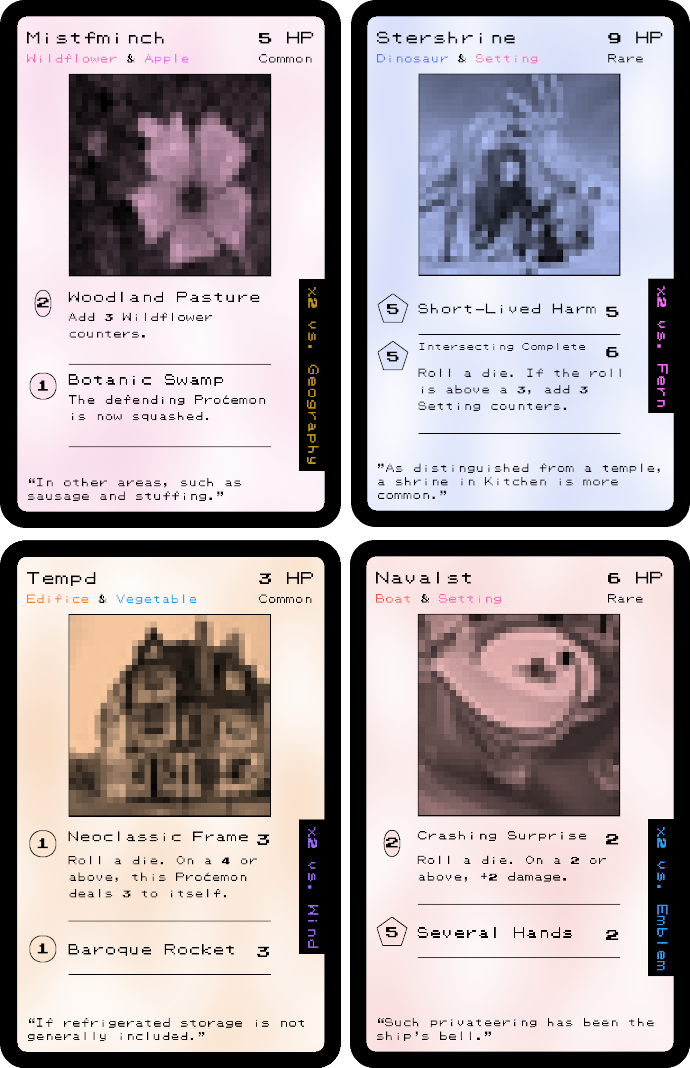Procedurally generated trading card game
Project description

Proćemon is a procedurally-generated trading card game from the exceedingly popular Proćemon media franchise. I found the source code under a truck so I leaked it online. You can use it to create your own unique decks.

Installation
- Get Python3
pip3 install procemon
Usage
- Either clone this repo or download this file.
cd path/to/the/file(Replacepath/towith the actual path to the repo or the directory where the downloaded file is located.)- Windows:
py -3 create_dex.pyOS X and Linux:python3 create_dex.py
Result: You will create a unique deck of cards.
What it does
- Create a "Dex" of a given number of "types" of Proćemon. Choose those "types" randomly.
- Generate Proćemon and assign them moves.
- Save a JSON object describing the Dex to disk.
- Get a sprite image for each Proćemon.
- Generate a card image for each Proćemon and save it to disk.
- Generate a temporary image of the back of a card.
- Create a PDF zine of some of the images.
How it works
Read the API documentation here.
- A Dex is a compendium of MonsterTypes. Per MonsterType, the Dex generates a given number of Monsters.
- Each MonsterType is stored as a JSON object here. MonsterTypes are a few important keywords (such as the name of the type) as well as:
- A list of
nounswhich will be used to generate monster names. MonsterTypes and their nouns were collected in several ways:- Reorganized from a pycopora dictionary
- Scraped from Wikipedia using Beautiful Soup
- Extracted from ImageNet synset hierarchies
- A list of
verbsand a list ofadjectives. These are used to create names of moves. Seeprocemon/data/moves/srcs.txtfor a list of sources. Verbs and adjectives are assigned to each monster type by runningprocemon/wv.pyit loads a Word Vector file. It then loads a list of verbs and a list of adjectives. Words are assigned to monster types based on their distance to the type. For example, if the type isflowerand the adjective isfloral, the distance will be really short, so now the adjectives dictionary will look something like:{"flower": ["floral"]}
- A list of
- A given number of Monsters are generated per MonsterType.
- Each Monster has 2 MonsterTypes. Each Monster's
nameis generated by combining part of a noun from the first MonsterType with part of a noun from the second MonsterType. - Each Monster has a
descriptioni.e. the flavor text at the bottom of the card. To generate the flavor text, it scrapes Wikipedia pages (with Beautiful Soup) using its MonsterType keywords (seeMonsterType.wikipedia) and its constituent nouns. It then creates a Markov chain model (using Markovify) from this text and to generate a short sentence. - Each Monster has a
rarity. This determines how "good" its stats are. In the Dex, each MonsterType has a certain percentage of card rarities (e.g. 20% of each monster type is Rare, and so on). - Each monster has a
strong_againstwhich is just the type one to the right of its "primary type" in the Dex array of MonsterTypes. For example if the array is["duck", "furniture", "fern"]then all Monsters with the primary type"duck"are strong against"furniture". (The order of this array is randomly shuffled whenever a new Dex is created.) - Each Monster has 2 Moves. Moves are generated using the Monster's first type (the "primary type").
- When the Dex is first created,
- There is also a list of generic "attack verbs" that any type can use and prefer if the move deals damage. These verbs are a very short distance away from the words like
"attack","battle", etc. These are calculated and cached via a word vector model when you runprocemon/wv.py(see above). - To get the
nameof a Move, a verb is first picked at random either from the "generic" verb list of the type-specific verb list. Then, sometimes a type-specific adjective is prepended to thename. - A
Movehas a certaincost. It might dealdamageand it might have aspecialeffect. The odds for how this is generated depends on the Monster'srarity.
- Once all of the monsters have been generated, the Dex can be saved as a JSON dictionary.
- Generate cards of each Monster by calling
Dex.create_cards()- A color palette is loaded. This array was derived from this image of the NES palette. Each MonsterType is associated with a "color index" representing a column in the palette array.
- For every MonsterType, the Dex looks for image URLs. It uses this file to look up "synset IDs" in ImageNet using the
MonsterType.imagenetandMonsterType.nouns. It tests each URL.- If it's a "good" URL (if an image is successfully downloaded), the Dex processes the image using PIL to make it look like a sprite and then adds it as an option for the next Monster of this MonsterTtype. The sprite is colorized using the color index in the palette.
- If it's a "bad" URL (and they often are) it is added to a list of known bad URLs so it doesn't waste time trying again.
- Once the images have been selected, a card per Monster is created and saved to disk using PIL.
- The background is colorized using the color index in the palette.
- Some Perlin noise is applied to the background.
- This is the font. This is where it's from.
- Optionally, a zine can be created of some of the cards in the Dex. This script will:
- Generate an image of the back of the card to use as the front and back cover of the zine.
- Start creating a PDF using fpdf.
- Randomly select some cards and add them as pages.
- Write the PDF to disk.
Changelog
1.2.1
- Updated the image of the cards in the README
1.2.0
- Removed types: Antelope, Mollusk, Raptor
- Added MANY more adjectives and verbs.
- Move names tend to be much more closely associated with the primary monster type.
- Added
wv.py. This script will pre-cache all of the verbs and adjectives per monster type rather than generating them at runtime with a word vector model.MonsterType(and the associated .json files) now have pre-cachedverbsandadjectiveslists.
- Moves that deal damage generally prefer attack verbs (see below).
- Fixed: Sometimes a move says that you should roll a die and on "1 or greater" the effect happens. Now, the minimum number is 2.
- Fixed: The first double-quotation marks in the monster flavor text at the bottom of the card is facing the wrong way.
- (Backend) Added:
attack_verbs.txtPre-cached attack verbs. - (Backend) Added:
src.txtSources for adjectives and verbs. - (Backend) Moved most of the code related to verbs and adjecives from
dex.pytowv.py
1.1.0
- Added a text file to the module to remember bad Wikipedia URLs so we don't test them again.
- Added monster types: Antelope, Antenna, Candy, Mollusk, Needlework, Sailor, Singer, Sphere, Tool, Tree.
- Fixed: Monster names sometimes end with
'S. - Fixed: Getting Wikipedia pages for flavor text and images for sprites is slow and your router might complain. Now, the HEAD headers are tested before the GET headers, which is a lot faster.
- Fixed: Sometimes, images are marked as "bad" when they're actually valid.
- Backend: Moved image URL testing in
Dextoget_image_from_url()so that this function can be tested externally.
1.0.2
- Minor update to README.
1.0.1
- Fixed: Data files aren't included.
Project details
Release history Release notifications | RSS feed
Download files
Download the file for your platform. If you're not sure which to choose, learn more about installing packages.
Source Distribution
procemon-1.2.1.tar.gz
(1.4 MB
view hashes)











